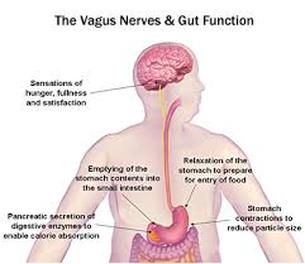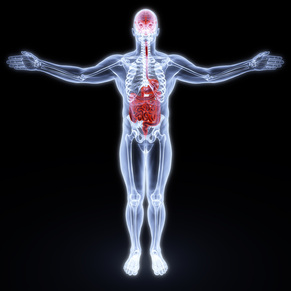We have known for some time that the bowel and stomach can send and receive information between the brain. The gut-brain axis is vital for maintaining conditions optimum for survival with bidirectional signalling between the gastrointestinal tract and the brain being regulated at neural, hormonal, and immunological levels. If we eat bad food our gut will warn us by a trigger to vomit or have diareaha. If we are eating and danger strikes we loose our appetite in favour of responding to the threat. Much of the information that loops from body to brain occurs via the vagus nerve, a master conduit that is present in all animals. Hardly a singular nerve, the vagus nerve is like a central tree trunk with roots reaching every organ in the body and branches projecting into the brain stem. It relays information to and from the body controlling and regulating the body’s essential functions, including heart rate.  The vagus nerve governs sympathtic and parasympathic nervous system responses - the 2 branches of the autonomic nervous system. The sympathetic branch tells to ready for danger, or alternately, the parasympathetic nervous system kicks in when danger is gone so we can relax. The vagus nerve has junctures at every organ in your body and nearly 80% of the vagus nerve mass is connected to the gut. The vagus nerve therefore serves evolutionary and survival purposes as well as keeping our heart rate, breathing and hormonal responses proportionate the the situation. The vagus supplies lightning fast information between body and brain, or more precisely the brain stem, which governs our survival reflexes. Imagine Neanderthal man (or woman) contemplating his or her next move. Should s/he dash accross out of the trees to escape a noise that could signal a predator, or should he stay and collect berries some more to satisfy his hunger? Who knows, most likely the first, suffice to say s/he didn't stand around thinking about it. The Neanderthal probably wasn’t very well informed by his cerebral cortex as it wasn’t well developed. However, many of us in times of threat aren’t either. When danger strikes we need to react. We often rely, as animals do, on visceral sensations to direct us. Visceral sensation comes from the viscera - the organs inside our body, and the body is the seat of the nervous system. Then the brain, or ‘head’ of the nervous system recieves the signal from the body and (maybe a sound or the feeling of vibration movement) and lightening fast we act or react. The brain doesn't really make any decision about real or perceive danger until much later. In fact, the brain can’t inform itself in times of imminent danger. Why? because the cerebral cortex, the higher cognitve area, goes offline when we are ‘reacting’! This has to happen simply because we don’t have time for thinking in times of danger- we need to move fast and we need to know in what direction and how fast, and if it is to defend ourselves or simply run. So the fight or flight system is run by the brain stem and the brain stem contains the clusters of nerves that form the origins of the vagus nerve. These nerves then disperse throughout the body and relay information back and forth at lightening fast rates. The vagus nerve connection is one hypothesis thought to drive how the gut might affect the brain It would make sense that food entering the gut can affect what the brain does given the brain is the head of the nervous system - For example, if we eat something bad we need to expell it as quickly as possible. The gut needs to signal the nervous system to increase peristasis so we can expell the toxic matter. To do this job the gut is well-supplied with nerves, but not just any sort of nerves.
The gut has a brain ! The gut is lined with neurons, about 500 million of them line the 9 meters we call the digestive system. In contrast, the brain only has about 100 million neurons, a 5th of what is in the gut. Knowing this we might be better off relying on our gut to inform us than our brain! And many times it does. We all say things like “I just can’t stomach that person.” or, “I had a gut feeling this was going to turn out bad.” Interestingly most of the feelings we get from our gut are either about trust and safety. Feeling something bad might happen or that someone is not to be trusted (or tolerated) seems to make sense of our ‘inner sense’. Just as we need to reject poisoness food, we need to keep away from dangerous people and situations and the vagus nerve not only carries information about danger, but informations about emotional situations. It is the emotional information superhighway of the body and there is a reason for this. The work of Stephen Porges has advanced information on the vagus nerve bundle to a new level with his polyvagal theory Porges discovered that the vagus nerve had 2 branches that operated differently. While 1, the dosal or old vagus performed the lightning fast evolutionary survival danger warning system mentioned above, while the other branch acted more like a social-emotional nervous system informing us about safety in social situations. The ventral or 'new' branch of the vagus nerve developed to assist us in forming social relationships. It helps us read faces and body cues of others by sending signals through the gut and nervous system and modualating our subsequent social reactions. This branch of the vagus nerve explains how we can feel instant shame in our body (cash flushes, hands go clammy) when we have recieved a scolding look. It explains the bodily discomfort we get in the presence of a person who is not acting in socially acceptable way toward us. It explains how we can feel sick to the stomach when we hear tragic news, why some creepy people ‘get our back up’, why we can’t eat when we are nervous and how a trip to the principals or bosses office can make your whole body stiffen. The vagus nerve is one explanation for the connection of mind and body, brain and gut, carrying sensory rich information influencing us emotionally, physically and mentally. I The bottom line is that the gut is the seat of emotions in the body informing our brain before our conscious mind has even had a chance to literally think. Posts regarding integrative medicine, human behaviour, psychotherapy, gestalt therapy, bio-chemical disorders; pyrrole, methylation, copper and zinc imbalances, child behaviour, family relationships, parenting.
0 Comments
Leave a Reply. |
AuthorClarissa Mosley Categories
All
Archives
November 2022
|

 RSS Feed
RSS Feed



